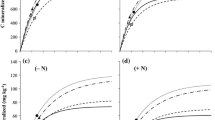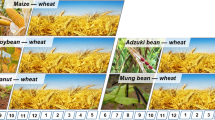Abstract
Integrated soil management with leguminous cover crops was studied at two sites in the northern Guinea savanna zone of northern Nigeria, Kaduna (190 day growing season) and Bauchi (150 days). One-year planted fallows of mucuna, lablab, and crotalaria were compared with natural grass fallow and cowpea controls. All treatments were followed by a maize test crop in the second year with 0, 30, or 60 kg N ha−1 as urea. Above ground legume residues were not incorporated into the soil and most residues were burned early in the dry season at the Kaduna site. Legume rotation increased soil total N, maize growth in greenhouse pots, and dry matter and N accumulation of maize. Response of maize grain yield to 30 kg N ha−1 as urea was highly significant at both sites and much greater than the response to legume rotation. The mean N fertilizer replacement value from legume rotation was 14 kg N ha−1 at Kaduna and 6 kg N ha−1 at Bauchi. W ith no N applied to the maize test crop, maize grain yield following legume fallow was 365 kg ha−1 higher than natural fallow at Bauchi and 235 kg ha−1 higher at Kaduna. The benefit of specific legume fallows to subsequent maize was mostly related to above ground N of the previous legume at Bauchi, where residues were protected from fire and grazing. At Kaduna, where fallow vegetation was burned, maize yield was related to estimated below ground N. The results show that legume rotation alone results in small maize yield increases in the dry savanna zone.
Similar content being viewed by others
References
Balasubramanian V & Blaise NKA (1993) Short season fallow management for sustainable production in Africa. In: Ragland J & Lal R (eds) Technologies for Sustainable Agriculture in the Tropics, pp 279–293. ASA Special Publication No. 56, Madison, Wisc., USA
Bremner JM (1965) Total nitrogen. In: Black CA (ed) Methods of Soil Analysis, Part 2, pp 1149–1178. American Society of Agronomy, Madison, Wisc.
Burle ML, Suhet AR, Pereira J, Resck DVS, Peres JRR, Cravo MS, Bowen W, Bouldin DR & Lathwell DJ (1992) Legume Green Manures: Dry season survival and the effect on succeeding maize crops. Soil Management CRSP Bulletin 92–04, Soil Management Collaborative Research Support Program, NCSU, Raleigh, North Carolina
Carsky RJ (1989) Estimating availability of nitrogen from green manure to subsequent maize crops using a buried bag technique. PhD dissertation, Cornell University, Ithaca, NY, USA, 257 pp
Costa FJSA, Bouldin DR & Suhet AR (1990) Evaluation of N recovery from mucuna placed on the surface or incorporated in a Brazilian Oxisol. Plant and Soil 124: 91–96
Dakora FD, Aboyinga RA, Mahama Y & Apaseku J (1987) Assessment of N fixation in groundnut (Arachis hypogaea L.) and cowpea (Vigna unguiculata L. Walp) and their relative N contribution to a succeeding maize crop in northern Ghana. MIRCEN J 3: 389–399
Elemo KA (1993) Maize (Zea mays L.) agronomy research in the Nigerian savanna. In: Fakorede MAB, Alofe CO & Kim SK (eds) Maize: Improvement, Production, and Utilization in Nigeria, pp 105–117. Maize Association of Nigeria, Ibadan, Nigeria
Fischler M (1996) Research on green manures in Uganda: Results from experiments conducted in 1995. Unpublished report submitted to the Rockefeller Foundation, Nairobi, Kenya, 31 pp
Greenland DJ (1985) Nitrogen and food production in the tropics: Contributions from fertilizer nitrogen and biological nitrogen fixation. In: Kang BT & van der Heide J (eds) Nitrogen Management in Farming Systems in Humid and Subhumid Tropics, pp 9–38. Institute for Soil Fertility, Haren, The Netherlands
Horst WJ & Hardter R (1994) Rotation of maize with cowpea improves yield and nutrient use of maize compared to maize monocropping in an Alfisol in the northern Guinea savanna of Ghana. Plant and Soil 160: 171–183
Jones MJ & Wild A (1975) Soils of the West African Savanna. Commonwealth Agricultural Bureaux, Wallingford, England
Lathwell DJ (1990) Legume green manures: Principles for management based on recent research. Soil Management CRSP Bulletin No. 90–01, Soil Management Collaborative Research Support Program, NCSU, Raleigh, North Carolina
LeBuanec B & Jacob B (1981) Dix-sept ans de culture motorisée sur un bassin versant du centre Côte d'Ivoire. L'Agronomie Tropicale 36(3): 203–211
MacColl D (1990) Studies on maize (Zea mays) at Bunda, Malawi. III. Yield in rotations with pasture legumes. Exper Agric 26: 263–271
Manyong VM, Houndekon AV, Gogan A, Versteeg MN & van der Pol F (1996) Determinants of adoption for a resource management technology: The case of Mucuna in Benin Republic. In: Zhang S & Wang Y (eds) Advances in Agricultural and Biological Environment Engineering. Proceedings of a conference (ICABE), Beijing, 15–19 August, 1996, pp I-86-I-93. China Agricultural University Press, Beijing, China
Mokwunye U (1980) Interactions between farmyard manure and fertilizers in savanna soils. FAO Soils Bulletin No. 43: 192–200
Oikeh SO (1996) Dynamics of soil nitrogen in cereal-based cropping systems in the Nigerian savanna. PhD dissertation, Ahmadu Bello University, Zaria, Nigeria
Pieri C (1989) Fertilité des terres de savanes. Bilan de trente ans de recherche et de développement au Sud du Sahara. CIRAD, Paris
Sanginga N, Ibewiro B, Houngnandan P, Vanlauwe B, Okogun JA, Akobundu IO & Versteeg M (1996) Evaluation of symbiotic properties and nitrogen contribution of mucuna to maize grown in the derived savanna of West Africa. Plant and Soil 179: 119–129
Tardieu M (1962) Le haricot dolique au Sénégal: Recherches sur cette espèce au CRA Bambey. L'Agronomie Tropicale 17: 33–36
Thomas D & Sumberg JE (1995) A review of the evaluation and use of tropical forage legumes in sub-Saharan Africa. Agric. Ecosys. Environ. 54: 151–163
Vine H (1953) Experiments on the maintenance of soil fertility at Ibadan, Nigeria, 1922–51. Empire J Exper. Agric. 21: 65–85
Weber G (1996) Legume-based technologies for African savannas: Challenges for research and development. Biol. Agric. Hort. 13: 309–333
Wetselaar R & Ganry F (1982) Nitrogen balance in tropical agrosystems. In: Dommergues YR & Diem HG (eds) Microbiology of Tropical Soils and Plant Productivity. Develop. Plant and Soil Science 5: 1–36
Wortmann CS, Isabirye M & Musa S (1994) Crotalaria ochroleuca as a green manure crop in Uganda. African Crop Sci. J 2: 55–61
Author information
Authors and Affiliations
Corresponding author
Rights and permissions
About this article
Cite this article
Carsky, R., Oyewole, B. & Tian, G. Integrated soil management for the savanna zone of W. Africa: legume rotation and fertilizer N. Nutrient Cycling in Agroecosystems 55, 95–105 (1999). https://doi.org/10.1023/A:1009856032418
Issue Date:
DOI: https://doi.org/10.1023/A:1009856032418




